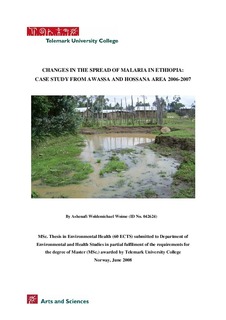| dc.description.abstract | Malaria is one of the world's most serious and complex public health problems. Four distinct specious of Plasmodium parasites, which are Plasmodium falciparum, Plasmodium vivax, Plasmodium malariae and Plasmodium ovale, is transmitted between individuals by Anopheles mosquitoes. Each year, it causes an estimated 400- 500 million cases and up to 2 million deaths, mostly children (WHO 1998, Guinovart et al. 2006). Malaria has been a major challenge to both public health and socioeconomic development particularly, in countries of sub-Saharan Africa. The nature of the topography and variations in climatic conditions indicates the long history of malaria in the Southern Nation Nationalities and Peoples Regional State (SNNPRS), particularly in Awassa and Hossana town and the country as a whole. The existing knowledge and distribution of malaria in Ethiopia has not been fully updated since an Italian investigator first established it in 1930s. For example, it was known that malaria transmission only occurred in areas below 2,150 m above sea level; now the limit has moved up to 2,500 m (Federal Democratic Republic of Ethiopia Ministry of Health (FDROEMOH) 2004). Although elevation is important, factors such as rainfall, temperature and precipitation levels play an important role in determining its intensity (Malakooti et al. 2000). The purpose of this writing is to find indications of relations between the spread of malaria and altitude, precipitation and area of open water surfaces. In addition to this, it is to look into the historical background of the malaria in Awassa and Hossana, and to give some possible solution on how to prevent malaria epidemics. The data collected during the fieldwork through questionnaire has shown that the number of malaria-infected individuals in the household has significant association with educational status of the householders (?2 = 8.81, P = 0.0122). It has connection with the presence or absence of drainage facilities, and the household?? family size (t = 21.7693, P = 0.0021). The place of work and the workers has shown little or no association with malaria (Ф = 0.227, P = 0.0611). In the study areas, malaria has no significant association with the income of the householders directly. | |
